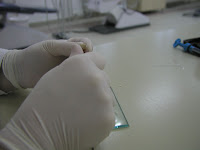The ISO4049 standard explains in detail how the depth of cure is measured and what is minimum depth that composites must have in order to comply with this standard. This simple procedure does not require sophisticated equipment and may be done in every dental office. It allows testing and comparison of materials and light curing units. Even if there is a radiometer to check the light intensity, it is recommended to measure the actual thickness of the composite cured by a a particular light curing unit.
Here is what we need:
Here is what we need:
- composite
- light curing unit
- cylindrical moulds (6 mm thick and 4-5 mm in diameter), originally it should be stainless steel, but plastic straws cut into moulds of this size may be used as well
- glass slab
- Mylar strips
- plastic filling instrument
- spatula or scalpel
1. Place the mould on the glass slab and fill it with composite.
2. Place the Mylar strip on top of the composite.
3. Light-cure the composite according the manufacturer's instructions (i.e. 40 s using a conventional or 20 s using a high-power halogen or LED light).
4. Discard the Mylar strip and remove the cured material from the mould.
5. Peel off the uncured material from the bottom side of the sample using the spatula or scalpel.
6. Measure the remaining thickness of the sample and divide this number by two. The ISO 4049 standard requires that the result should be at least 1.5 mm for non-opaque shades and 0.5 mm for opaque shades.
2. Place the Mylar strip on top of the composite.
3. Light-cure the composite according the manufacturer's instructions (i.e. 40 s using a conventional or 20 s using a high-power halogen or LED light).
4. Discard the Mylar strip and remove the cured material from the mould.
5. Peel off the uncured material from the bottom side of the sample using the spatula or scalpel.
6. Measure the remaining thickness of the sample and divide this number by two. The ISO 4049 standard requires that the result should be at least 1.5 mm for non-opaque shades and 0.5 mm for opaque shades.
















14 comments:
I read over your blog it is really useful. I am definitely going to visit again. Thanks for sharing!
I saw your method of measuring the thickness of the cured composite. I have a query,you did not mention the time after which to remove the uncured composite. as the composite will continue to polymerize even after the application of light. so I think there must be some time limit.
Dr Khattak, thanks for your comment. You remove the uncured material right after curing.
Nice post. i really like your blog. Thank you for an informative blog which gives helpful information.
Michigan Dentist
This is really amazing information here i found which are useful for me, great blog you have shared.
affordable dentures
Thanks.....
I loved the information shown above. Pretty unique. What is that digital machine called?
The optimal degree of curing throughout the bulk of a visible light-activated dental resin composite is acknowledged to be important to the clinical success of a resin composite restoration. Unfortunately, the dentist has no means of monitoring the cure of the resin surfaces not directly exposed to the curing light. Techniques, such as the layered buildup of restorations in 2 mm increments with longer activation times than 20 seconds, have been suggested.
brian donlon reviews
This is a nice post with a great visual which is really good.
thank u so much.
what about the plastic mold is enough ????? bcz most studies uses stainless steel or brass ....whether it can cause any alteration in results obtained?????
what about acetone or ethanol for removing uncured materials... whetherit has any advantage than using plastic spatula....????????
Hi, Nishad
Yes, you can use the plastic mould as well as stainless steel. Plastic won't cause any alteration in the results regarding the depth of cure.
You can also use the acetone/ethanol shaking test to remove the uncured material using either of these organic solvents. In fact, I've explained this test in another post. Check out this link:
http://dental-materials.blogspot.com/2013/04/depth-of-cure-of-composites.html
Regards
Dr Vesna Miletic
hi Vesna,
i was wondering why do we divide the the absolute lenght by 2?????
any idea?????
Hi, Dalia
Dividing the remaining sample thickness by 2 is sort of a "safety" measure. You may be unable to scrape some material at the bottom but this does not mean it is fully cured. A previous guideline suggested that the bottom-to-top hardness ratio should be 80% to consider material fully cured. Some studies compared this ISO standard with this hardness ratio and concluded that dividing the remaining sample thickness by 2 results in a relatively precise depth of cure.
Regards,
Vesna
thanks for ur reply
but where can i find the iso standards???
my supervisor is asking for it and i cant find it anywhere
can u plz help
Hi dalia .....
Go to the following link .. yoou ll get the iso requirements in its exact form......
http://www.ada.org/sections/scienceAndResearch/pdfs/0810_corematerials_testmethods.pdf
With regard.......
Dr. nishad
Post a Comment